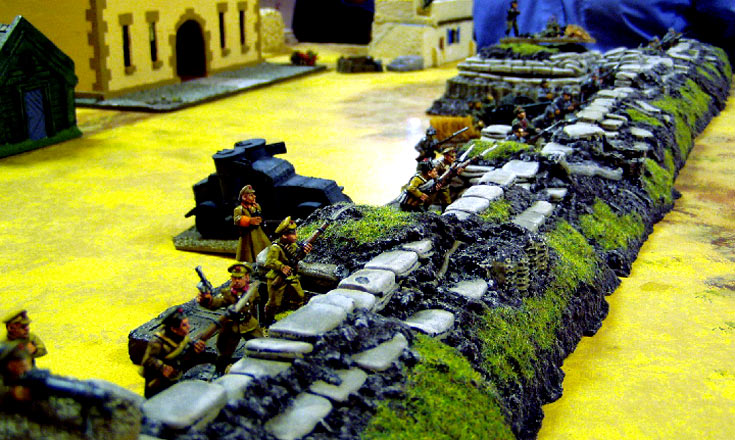
The Storming of Ashkabad, 1920
20th June 2006, Comments Off
Back of Beyond, Contemptible Little Armies / Back of Beyond, 28mm
 In Edinburgh a group of us have been running a “Back of Beyond” campaign for some years using 25mm figures. Actually I’m something of a latecomer to this, and just about the only army which hadn’t been taken was the Turks. It just so happened that I’d already started building up a WW1 Turkish army, so before you knew it Gus Pasha was champing at the bit ready to invade Central Asia. In the last few months of campaigning the Turks captured Baku on the Caspian Sea, then in Journal 1 I reported how my Turks successfully stormed ashore at Krasnovodsk, and so gained a foothold in Central Asia. Well, the next place down the railway line heading east was Ashkhabad, where a Red garrison was being besieged by the Whites – and had been for about a year.
In Edinburgh a group of us have been running a “Back of Beyond” campaign for some years using 25mm figures. Actually I’m something of a latecomer to this, and just about the only army which hadn’t been taken was the Turks. It just so happened that I’d already started building up a WW1 Turkish army, so before you knew it Gus Pasha was champing at the bit ready to invade Central Asia. In the last few months of campaigning the Turks captured Baku on the Caspian Sea, then in Journal 1 I reported how my Turks successfully stormed ashore at Krasnovodsk, and so gained a foothold in Central Asia. Well, the next place down the railway line heading east was Ashkhabad, where a Red garrison was being besieged by the Whites – and had been for about a year. Of course when the Turks showed up it was game over. Having failed to reach an agreement with the Bolshevik commander I laid plans to assault the town in conjunction with a White attack.
Of course when the Turks showed up it was game over. Having failed to reach an agreement with the Bolshevik commander I laid plans to assault the town in conjunction with a White attack. We both used screens of Turkoman allies – wild tribesmen whose great saving grace was that they were cheap in points, and seemed willing to act as a “human shield” to protect the Turkish infantry as they advanced. The Turkomans were borrowed from the collection of Colin Jack – also the photographer and the White commander. Supported by an armoured car the Turks silenced the defender’s guns, then breached the city defences – one step ahead of the Whites who were doing the same thing on the far side of town.
We both used screens of Turkoman allies – wild tribesmen whose great saving grace was that they were cheap in points, and seemed willing to act as a “human shield” to protect the Turkish infantry as they advanced. The Turkomans were borrowed from the collection of Colin Jack – also the photographer and the White commander. Supported by an armoured car the Turks silenced the defender’s guns, then breached the city defences – one step ahead of the Whites who were doing the same thing on the far side of town. As the game ended the Turks were dealing with the Cheka who were making a last stand, while the rest of the Turkish army was busy occupying as much of the town as it could before their White “allies” arrived. It was a fun game (although the red commander might disagree), and like all these “Back of Beyond” games it gave us the chance to field some unusual troops and put them in an even stranger situation. As always the rules were Chris Peers’ “Contemptible Little Armies“.
As the game ended the Turks were dealing with the Cheka who were making a last stand, while the rest of the Turkish army was busy occupying as much of the town as it could before their White “allies” arrived. It was a fun game (although the red commander might disagree), and like all these “Back of Beyond” games it gave us the chance to field some unusual troops and put them in an even stranger situation. As always the rules were Chris Peers’ “Contemptible Little Armies“.

